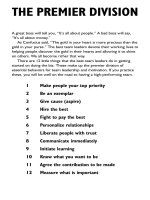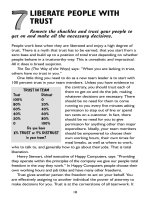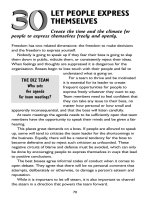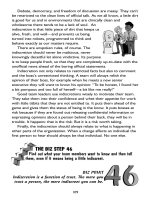NVL sharing motivation team
Bạn đang xem bản rút gọn của tài liệu. Xem và tải ngay bản đầy đủ của tài liệu tại đây (3.78 MB, 17 trang )
Training Material
Motivating Your Team
Novaliches Sharing
Contents
1.
Introduction
1
2.
What is Motivation?
2
3.
Motivation in Theory
3
4.
Improving Motivation
6
5.
Key Learning Points
14
6.
Further Reading
15
Motivating Your Team Bite-Sized Training™ | Mind Tools
iii
1. Introduction
W
e’ve all heard the expression, “You can lead a horse to water but you
can’t make it drink.” Similarly, you can encourage the members of
your team to take certain actions but, when it comes to delivering
their best at work, they need to motivate themselves.
Humans are pre-wired to be motivated. We get up every morning for a reason
(whether it’s the need for coffee or food), and we’re motivated to go to work (even
if it’s just to receive a paycheck). However, to build an effective team, you need
people who want to achieve more than these basic requirements.
People who are motivated to this higher level are engaged at work, and they’re
interested in making their organization better. It’s your job to inspire and develop
this kind of motivation, and to make sure that your team members are fired up and
are working passionately towards a shared vision of the future. You can do this by
providing an environment rich in motivating factors, aligning your team members’
objectives with organizational goals, and communicating an inspiring vision.
In this Bite-Sized Training™ session, lasting around one hour, we’ll explore
the theory behind motivation, and we’ll identify how you can create a richer
motivational environment for your people. Specifically, you’ll:
•
•
•
•
Learn about Maslow’s and Herzberg’s theories of motivation in
the workplace.
Find out how effectively you are motivating and satisfying members of
your team.
Discover some tools to increase workplace motivation.
Develop a plan to put these strategies in place.
Let’s start by looking at the importance of motivation.
Motivating Your Team Bite-Sized Training™ | Mind Tools
1
2. What is Motivation?
T
•
•
•
•
•
•
his simple equation shows the importance of motivation:
Job Performance = Ability x Motivation
When your team members are motivated, they’ll likely experience:
Higher morale.
Improved performance.
Deepened appreciation for internal and external customers.
Increased energy levels and resilience to stress.
Improved attention to quality.
Increased creativity and good humor.
You may also see:
•
•
•
•
Better employee retention.
Decreased absenteeism and burnout.
Improved customer care and service delivery.
Enhanced teamwork, with more trust and enjoyment at work.
Next, we’ll explore how you can achieve these benefits.
Motivating Your Team Bite-Sized Training™ | Mind Tools
2
3. Motivation in Theory
Maslow's Hierarchy of Needs
Maslow’s Hierarchy of Needs is one of the most popular theories of human
motivation. Abraham Maslow grouped together the various needs that people
have, and represented them as five distinct levels in a pyramid:
Figure 1: Maslow's Hierarchy of Needs
This theory contends that, as we strive to meet our most basic needs, we also seek
to satisfy a set of higher requirements. The first level of the pyramid represents
our physiological need for food, water and shelter, and this is followed by our
safety and social needs. (Maslow believed that the higher-level needs, such as
self-esteem and self-actualization, could only be met after the lower ones had
been satisfied. That’s not necessarily what people think now.)
When we’re satisfied at work, we’re free to be fully productive and effective. When
we aren’t, we’ll likely become preoccupied with finding other ways to fulfill our
needs, we may lose interest in our jobs, and our productivity, engagement, morale,
enthusiasm, and enjoyment can all suffer.
Tip:
Other motivational hierarchies exist, but Maslow’s theory is particularly useful.
Find out more about it in this article.
Motivating Your Team Bite-Sized Training™ | Mind Tools
3
Clearly, motivation in the workplace is very important. But how can you provide a
motivating environment that caters to each person’s individual needs?
This is where Frederick Herzberg comes in…
Herzberg's Motivators and Hygiene Factors
Frederick Herzberg extensively researched human needs at work, and developed
his Motivation and Hygiene Factors Theory based on his findings. He argues that
people have two types of needs:
•
•
Hygiene needs (fundamental factors that must be in place before any
motivational approaches will work).
Motivational needs.
Hygiene factors relate to working conditions, while motivational factors refer to
elements that enrich a person’s job.
Herzberg uses the terms “job satisfaction” and “dissatisfaction,” and it’s important
to note that these aren’t opposites. For example:
•
•
Team member dissatisfaction comes from hygiene factors. Dealing
with these won’t actively improve motivation, but you won’t be able to
motivate people until these are out of the way.
Team member satisfaction comes from motivational factors. Once
the hygiene factors are addressed, people can then be motivated by
higher-level elements such as added responsibility or opportunities
for advancement.
Examples of Factors for Dissatisfaction
(Hygiene Factors)
Examples of Factors for Satisfaction
(Motivational Factors)
Unnecessary policies and practices.
Meaningful work.
Inadequate compensation.
Recognition of achievement.
Job insecurity.
Opportunity for advancement.
Uncooperative coworkers.
Responsibility.
Unpleasant supervision.
Personal development.
Uncomfortable working environment.
Training.
When you provide a work environment that’s rich in motivational factors, your
team members will likely experience increased job satisfaction, and they will be
free to contribute fully to the team and focus on achieving its goals.
Motivating Your Team Bite-Sized Training™ | Mind Tools
4
Tip:
Learn more about Herzberg’s Motivators and Hygiene Factors Theory in
this article.
Tip:
Read our articles on McClelland’s Human Motivation Theory, Sirota’s
Three-Factor Theory, and Amabile and Kramer’s Progress Theory to find out
how to customize your motivational approach.
Motivating Your Team Bite-Sized Training™ | Mind Tools
5
4. Improving Motivation
N
ext, we’ll explore how you can improve your team members’ motivation
by taking these seven steps:
1.
2.
3.
4.
5.
6.
7.
Assessing hygiene factors.
Resolving hygiene factor issues.
Recognizing achievements.
Investigating other options to motivate people.
Looking at compensation.
Improving your leadership style.
Taking action!
Note:
You may not be able to complete this section fully in one hour, but you’ll be off
to a great start!
1. Assessing Hygiene Factors
Action:
Spend a few minutes thinking about your current work environment.
Consider the hygiene factors listed on the page 4, and assess how these
could affect each member of your team. On the next page, list any issues
that may be objectively problematic, undermining morale, or causing
unhappiness. Use the table on page 4 as a starting point, but consider other
team-specific factors.
Don’t worry about improving satisfaction and motivation at this stage, we’ll
come back to this later.
Tip 1:
You may be aware of the issues that people are experiencing. At an
appropriate time, have a quiet chat with trusted team members to learn what
people are thinking.
Motivating Your Team Bite-Sized Training™ | Mind Tools
6
Tip 2:
Remember, different people in different situations and at different stages of
their lives have different needs.
Tip 3:
There will likely be specific issues that we haven’t included in our general list
of hygiene factors. Think about any that may be relevant to your industry or
situation, and include them.
Possible Hygiene Factors
Motivating Your Team Bite-Sized Training™ | Mind Tools
7
2. Resolving Hygiene Factor Issues
Once you’ve identified your team’s hygiene factor issues, dedicate a suitable chunk
of time to addressing them. This is an essential and easily justifiable task – after
all, it’s your responsibility as a manager to help your team members perform at
their best.
Remember, it’s important to address hygiene factor issues first, according to
Herzberg, or your efforts to increase motivation will likely fail. After all, team
members who are fundamentally dissatisfied aren’t likely to respond to any efforts
to improve their motivation!
3. Recognizing Achievements
Recognizing achievements is a simple and extremely effective way to motivate
your team members, and it’s shockingly underused in many workplaces. Many
people get so caught up in their own work that they forget this simple courtesy.
You can easily say “thank you” or compliment someone on a recent achievement
– it costs nothing and it means everything! These actions help your people feel
valued and motivated, so that they want to perform well.
Make sure that you congratulate your team members as soon as they experience
success. Don’t assume they know that you’re happy with their work – tell them.
Don’t be quietly pleased – tell them…
When you regularly recognize people’s achievements, it becomes second nature.
What have your team members done well? How have they exceeded your
expectations? Do people know you value their work? Have you recognized their
achievements? If in doubt, make a conscious effort to reward people’s efforts from
now on.
Note:
Be aware that people can be motivated (and demotivated) by your
expectations of them. Read our article on the Pygmalion Effect for more
on this.
Effective recognition should demonstrate the following six qualities:
•
•
•
•
Genuine: It should not be forced or have an ulterior motive. Find
something genuinely good, so you won’t feel the need to qualify
your praise.
Spontaneous is best, as over-planned efforts may seem false.
Personal: It must mean something special to the recipient, and he or she
should be singled out for praise. (Not, “You guys did a great job controlling
the reporters today.” Say instead, “Rashid, the way you handled those
journalists was awesome.”)
Specific: Your recognition should be more than “good job” or “way to go”;
you’re acknowledging a specific action.
Motivating Your Team Bite-Sized Training™ | Mind Tools
8
Timely: Make it as close to the event as possible – this reinforces spontaneity.
Public: Recognition is often reinforced by public acknowledgment. But be
aware that some people may feel uncomfortable about being singled out
– so choose the right moment.
•
•
To get into the habit of doing this, why not put a regular reminder to recognize
your team members’ achievements in your calendar or To-Do List, and ask yourself
each week, “Who deserves praise for their successes?”
4. Investigating Other Options to Motivate People
Next, we’re going to look at other ways you can motivate your team members.
Often, people instinctively assume that compensation and benefits are the only
motivators. But, these aren’t always viable options, as managers may only have
very limited discretion to increase compensation.
So, your job is to use the satisfaction factors listed on page 4 to motivate
your people.
Action:
Using Maslow’s Hierarchy of Needs and Herzberg’s Motivators and Hygiene
Factors, brainstorm ways you can improve your team members’ motivation
and write them in the box on the next page. Remember to include factors that
may be specific to your industry or situation.
Make sure that you consider the following options:
•
•
•
•
Entrusting individuals with new responsibilities.
Organizing a team social event to celebrate a project success.
Encouraging people to make suggestions and implement their own
ideas to improve the workplace.
Brightening up the office with a new coat of paint, pictures or posters
chosen by the team, or some plants.
Motivating Your Team Bite-Sized Training™ | Mind Tools
9
5. Looking at Compensation
Although using compensation and benefits to motivate your team members isn’t
always possible, it is important. Your top performers’ achievements should be
acknowledged, and you may have to fight to get them the financial recognition
they deserve.
In larger organizations, you may only have the authority to increase financial
compensation if you directly influence HR policy. In smaller teams within global
organizations, you may have limited control over compensation or performancerelated pay. In small businesses, however, these options may be within your reach.
Let’s look at some common compensation and benefits practices that you can use
to motivate people.
Compensation:
•
•
•
Performance-related pay, profit-related bonuses, stock option plans, and
profit sharing.
Paid leave banks.
Achievement-based rewards, such as dinner certificates, tickets to cultural
or sporting events, and so on.
Motivating Your Team Bite-Sized Training™ | Mind Tools
10
Working hours:
•
•
•
•
•
Flexible schedules.
Compressed workweeks.
Job sharing.
Telecommuting.
Sabbaticals and unpaid leave.
Training and development:
•
•
•
Developmental opportunities, such as skills training.
Career planning.
Internal advancement opportunities.
Different things motivate different people, which is why personalized rewards
programs that offer individuals a choice of compensation are often effective.
For example, some people are highly motivated by the opportunity for career
development, while others may value flexible working hours, or the option to
work remotely.
Action:
Consider whether the options above might benefit individual members of
your team. Write down your thoughts below. (Clearly, you need to discuss
these with your HR department!)
Motivating Your Team Bite-Sized Training™ | Mind Tools
11
Tip 1:
Remember, pay increments are expected, and their motivational impact can
be short-lived. Didn’t you feel like your past incremental raises were deserved?
Did they actually motivate you? Pay and conditions are often hygiene, not
motivational, factors.
Tip 2:
It’s easy to focus on the higher levels of Maslow’s Hierarchy when you’re in a secure
position. However, money quickly becomes very important when you’re not.
6. Improving Your Leadership Style
Following these steps helps ensure that your team members are happy, fulfilled
and motivated. However, it doesn’t guarantee that they are emotionally fired up
and are working passionately towards an inspiring, shared vision of the future.
There are two important leadership theories you can use to inspire your people.
These are Management by Objectives and Transformational Leadership.
i. Management by Objectives
This type of management aligns team members’ objectives with organizational
goals. It allows you to translate the company’s mission into a format that will
inspire individuals, and increase their motivation, dedication and loyalty. You
keep people informed about strategy, regularly remind them about the corporate
mission, and invite them to participate in some business decisions.
When you do this, people are clear about their work and how it benefits the
organization, they understand the purpose and meaning of what they do,
they take responsibility for their performance, and they can see how their
achievements affect the company as a whole.
ii. Transformational Leadership
Taking steps towards becoming a transformational leader will help you to develop
and communicate an inspiring vision of the future. As a transformational leader,
you remind people of the purpose of their work, show integrity, and “walk the
walk,” so that you demonstrate the high standards you expect from others.
This type of leader has high expectations, but they set clear goals and provide
support, encouragement and recognition. They create an inspiring vision, motivate
people to buy in to it, manage its delivery, and inspire trust and loyalty in their people.
Tip:
See our articles for more on how to use Management by Objectives and
Transformational Leadership to inspire your people.
Motivating Your Team Bite-Sized Training™ | Mind Tools
12
Action:
Consider how you can use Management by Objectives and Transformational
Leadership to inspire your team members. Write your thoughts below.
Management by Objectives
Transformational Leadership
7. Taking Action!
Now, think about how you’ll apply what we’ve covered in this session, add these
actions to your To-Do List, and get on and do them!
Motivating Your Team Bite-Sized Training™ | Mind Tools
13
5. Key Learning Points
M
otivated team members are satisfied, and they tend to be much more
productive than people who aren’t happy at work.
In this session, we looked at Maslow’s Hierarchy of Needs and
Herzberg’s Motivators and Hygiene Factors Theory, which help you
identify sources of satisfaction and dissatisfaction for your team members. First,
you need to deal with any hygiene factor issues, so that their basic needs are met,
before you can motivate them further.
Next, you need to recognize your team members’ achievements, as this is
the ultimate source of motivation. Fortunately, this is free and easy: just keep
reminding yourself to say “thank you,” and it will become a good habit.
You can also motivate your team members without great expense by applying
Herzberg’s theory. However, compensation is an important hygiene factor, so you
may need to fight to ensure that your high performers are paid fairly.
Finally, use Management by Objectives to translate your organization’s mission
into a format that will inspire people, and take steps towards becoming a
Transformational Leader, so that you can develop and communicate a shared,
motivational vision of the future.
Motivating Your Team Bite-Sized Training™ | Mind Tools
14
6. Further Reading
T
•
•
•
•
•
•
his Bite-Sized Training session has explored how you can motivate your
people using Maslow’s Hierarchy of Needs and Herzberg’s Motivators and
Hygiene Factors Theory. You can use the resources below to learn more
about motivating people:
Alderfer’s ERG Theory is based on Maslow’s Hierarchy, but also takes
account of the simultaneous nature of its five needs.
Sirota’s Three-Factor Theory looks at three factors that affect employee
enthusiasm.
McClelland’s Human Motivation Theory examines whether a person’s
primary motivation is for achievement, affiliation or power.
Theory X and Theory Y examines how your management style is
influenced by your beliefs and assumptions about what motivates your
team members.
Expectancy Theory looks at how you can motivate team members by
linking effort with outcome.
Progress Theory explores how you can motivate people by helping them
achieve “small wins.”
Tip:
You can also develop your motivation skills further by taking our How Good
are Your Motivation Skills? self-test.
Source from Mindtools
Motivating Your Team Bite-Sized Training™ | Mind Tools
15









